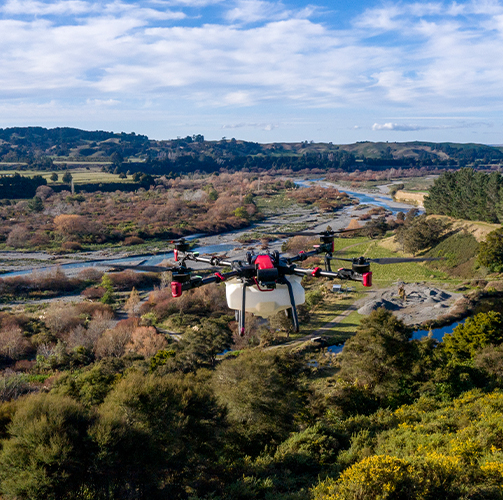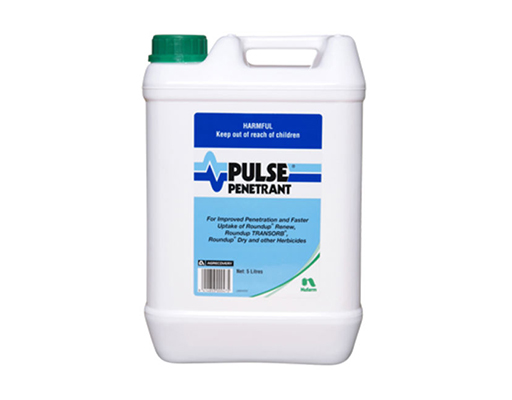

Sky's The Limit for Drone Spraying
Drones are the next frontier in agricultural spraying, although challenges remain for operators. We meet two brothers who have jumped into this fast-developing field, and learn how Nufarm and Farmlands have been supporting their business.
It’s a long way from the valleys of Wales to the hills of Hawke’s Bay, but for Stu and Russell Davies at least one thing feels familiar - the rain. There was plenty of it after Stu took over the well-known local contracting business Fogarty Spraying at the start of 2023, having previously driven the company’s distinctive green spray trucks for three years after arriving in New Zealand.
“Prior to Cyclone Gabrielle, we had 24 months of solid wet weather, so we were already having some issues, but after the cyclone we were having trucks getting stuck,” he says. “We were going out and doing a job and coming back into the yard on a minus profit, just to try and provide the client with the service that we normally would.”
Stu says he was having to wear the costs of taking as long as three hours to spray just 5-7ha of land. “It was not sustainable in that circumstance and, as they keep mentioning, with climate change, where's it all going? How do we continue running an efficient business with those losses? You just end up going broke.”
Searching for solutions, Stu started investigating other options he could offer clients that weren’t available in the area. That was when he came across the emerging technology of drones. “The drone space has been ongoing for the last five to six years in New Zealand, but it's never had the capacity: it's always been 15-20L, which is not sustainable to balance the equivalent output of a truck ground sprayer at this point.”
However, with the arrival of bigger drones with 50L spray capacity, Stu saw an opportunity. “That's where we decided to look at the option and what it was going to cost to set up. There were extra costs involved along the way, but that's what you'd get from taking a new venture on.”
Results Assured
Stu’s biggest dilemma was quickly solved when he recruited his brother Russell (who had been working on a DOC riparian planting project in the South Island) to pilot the drones. One thing Stu didn’t have to worry about was the quality of his spray product.
Paul Greenbank – Nufarm Territory Manager for Hawkes Bay and Wairarapa, says Nufarm had a longstanding relationship with Fogarty Spraying prior to the drone coming on board. “We ensure that our products are readily available to Stu and his team so they can spray the minute they need to.”
Stu says they use a slightly different mix of Nufarm products for their drone spraying compared to other spray methods. “Associate and Conquest are definitely the two main chemicals I've added to the list with Nufarm and that is basically all down to the demand of blackberry spraying, which is a very specialist area that I've tried to utilise that drone for.”
Those products are seeing great results out in the field, says Stu, noting that some clients are happy for them to supply the spray while other clients have their own spray for them to use. For example, they recently did a desiccation job of some sweetcorn for local dairy farmer Paul Franklin, using Paul’s own supply of products.
The other main products they have used on Paul’s farm are Kamba 750 and Conquest, Stu says. “Paul buys a lot of Nufarm products as well and we've also done the blackberry bush spraying on a part of a terrace up at the dairy farm there.”


Getting Off the Ground
Although the Davies brothers are getting great client feedback for their drone spraying, the process of getting the drone in the air was not without hurdles. The first step was to pick a drone, and after some research they chose the XAG P100 PRO Ultra High-Capacity Spray Drone (50L) from Aerolab, an XAG distributor based in Auckland.
“Stu saw the XAG with Aerolab at one of the Field Days events in Feilding and got talking to them and that was it really,” says Russell. “In hindsight we probably made the right choice going with XAG. For starters, ours has a 50L tank rather than 40L, and from what I've seen, the software and the autonomous flight is a bit more efficient with the XAG system.”
The 50L model had only just been released when they ordered it, so they had to wait for it to arrive in the country. “In the meantime, the Ukraine war started up, so China actually put a restraining order that stopped any drone 25kg or bigger from leaving China, which gave us a big delay,” Stu says.
Getting the drone was the easy part; Russell had to complete not one but four separate courses to be legally allowed to use it for agricultural spraying. “The number of boxes to tick is quite impressive,” he says. “I think because it's still quite new, the various organisations that are governing this are still catching up in terms of streamlining the process.”
Another area that is still catching up to the growing use of drones for spraying is the labels for the spray products, including the recommended water rates. Mike Cox, South Island Sales Manager for Nufarm, says they are working on updating their labels to reflect the differences between drone spraying and other methods. “It's amazing technology but have the labels caught up with the way the technology has evolved? No, and we understand that.
“There are other countries around the world who are doing the same thing, playing a little bit of catch up footy with the way labels are written and the way that the drone technology and atomisation of the droplet is evolving. The other part of it too is not only the products but the adjuvant space as well.”
Doing the Research
Before embarking on his drone journey Stu did market research, talking to farmers and getting advice from local Farmlands TFOs about the appetite for such a service. “It was just a new space. Not too many farmers like change that much, if the system works and it does what it says on the tin.” While some farmers and growers were sceptical at first about using a drone, the reaction from clients has been “bloody good”, Stu says.
“There aren’t many jobs that Russ can go to and doesn't have an audience. If the spray truck turns up, you bugger off but a drone turns up? Let's call the neighbours and let's all have a nosy. It’s usually the main entertainment on the hillside watching him flying this machine, and all credit to him, he deals with it well.”
Farmlands Agronomist Joseph Butler commends Stu for being able to build his business during a “very difficult” two years. “He just relates to the shareholders so bloody well and the staff at the store like him. He just gets along with everyone, and I think that's just one of the big points when you start up a business like these guys are doing, it all comes down to relationships.”
Joseph says drones are an exciting addition to the toolbox, and everyone involved is still learning what they can do. “You’ve got to work with Nufarm on things like water rates and chemical application; realistically it's about seeing it in action, seeing what the results are and then teaching and training up the TFOs to actually push it on farm. It's just going to open up a whole new world of options.”
Paul Greenbank says, “At Nufarm we pride ourselves on adding value to Contractors like Stu. Whether it is through innovative solutions, providing technical support and back up, or our range of high-quality products. That way, Stu can spray exactly what he needs when he needs to.”
FEATURED PRODUCTS



Nufarm Kamba 750 10L
A selective herbicide for the control of difficult broadleaf weeds in cereals, maize, pasture, plantain and waste areas.

Nufarm Pulse Penetrant
Nufarm Pulse Penetrant is an organosilicon based surfactant that, because of its superior wetting ability, has a significant advantage when used with glyphosate.